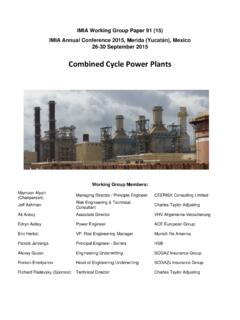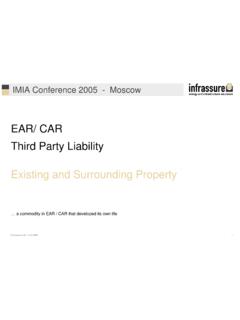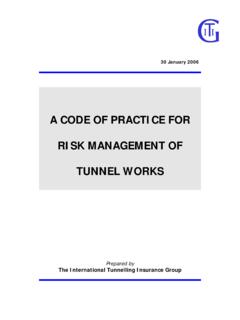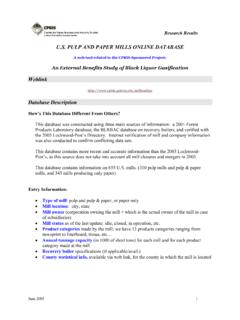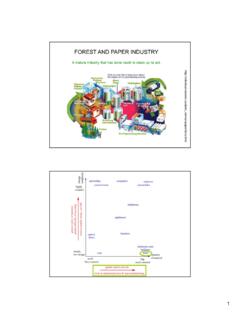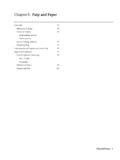Transcription of Hazards in paper and pulp industries – from an engineering ...
1 1 Hazards in paper and pulp industries from an engineering insurance perspective. IMIA WGP 49 (06) By Aki Ahonen Pohjola Ingvar Bodin Zurich Milan Dinets Ingosstrakh Mats G din If P&C Chairman Felix Staub Swiss Re Thomas str m Pohjola Presented at the IMIA Conference in Boston, 12 September 2006. 2 Table of Contents 1 Introduction 4 General trends in the pulp and paper industry in the world. 4 Content of this paper 5 References 6 2 Technical descriptions and development 6 pulp 6 Sulphate pulping ( Kraft pulping) 6 Risks related to Kraft pulping 6 New chemicals for bleaching processes 6 Size increase of key machinery 7 Sulphite pulping 8 Special risk of sulphite pulping 8 Recycled pulping and deinked pulps 9 Mechanical pulp 9 Energy and chemical recovery 9 Kraft recovery boiler 10 General 10 Description 10 Special considerations 12 Trends in designing new recovery boilers 13 Black liquor gasification combined cycle 14 paper Machine 14 paper and board production in general 14 Contemporary technology and trends of paper and board machines 15 Dilution controlled head-box 15 Shoe press 16 Impingement drying 17 Tissue paper production 18 Technical trends and risks in general 19 Environmental aspects 20 Water treatment 20 Air purification 21 References 22 3 Loss prevention 23 General considerations 23 The most frequently used machine diagnostic methods 23 Critical components 24 Conveyors 24 Chippers 24 Digesters 25
2 Diffusers 25 Black liquor recovery boiler 26 Boiler fans 28 Lime kiln 29 Steam turbo sets 29 Main transformers 30 paper machine 31 Yankee Dryers 31 3 References 32 4 EML / PML estimation. 33 Loss scenarios 33 MPL scenario 33 PML scenario 33 Additional helpful information 34 5 Examples of losses 4 1. INTRODUCTION General trends in the pulp and paper industry in the world. The first paper was produced some 2 000 years ago by a Chinese named Ts i Lun, and paper has become one of the most important inventions ever. The production of paper increased by more than 460% between 1961 and 2004, whereby production has increased from 77 000 000 ton/year to 360 000 000 ton/year in the pulp and paper industries . The main paper products are writing and packaging paper representing more than 60% of the total production ( ).The total production of pulp during 2004 was 188 000 000 tons, the main quality being chemical pulp ( ).
3 The amount of paper , which is recycled, is 48% of the paper production in the world. In Germany, Finland, Switzerland, Sweden and Japan more than 70% of the paper is recycled. paper production in the world 2004 by productOther paper8%News print11%Fine and writing paper31%M aterial fo r co rrugated30%Carto n bo ard13%Tissue7% pulp production in the world by productOther10%Mechanical18%Chemical 72% Figure 1. paper production in the world 2004 by product /1/ Figure 2. pulp production in the world by product /1/ The demand for paperboard in the world is expected yearly to grow by 2,1% in the long term, reaching 490 million tons by the year 2020. The major part of new paper production capacity has during the last years been built in Asia. There has been an increase of 37 000 000 tons paper production capacity in Asia between 1995 and 2004 /2/. Between 1990 and 2005 a consolidation within the pulp and paper industry has taken place and is still continuing, so today the ten largest companies represent 27 % of the production capacity in the world ( ) compared with 16% in 1990 (Jaakko P yry) /3/.
4 The concentration has been very local and the merges or acquisitions have been with firms working in the same region. 5 Figure 3. Leading paper companies in the world 2005 /3/ The demand for paper will increase mainly in Asia and Eastern Europe during the next 15 years (Fig. 4). This will imply that the production of paper and pulp will gradually be shifted from today s countries to Asian countries ( ). Figure 4. paper and paperboard demand forecast Figure 5. Production prospects 2004-2020 /3/ through 2020 /3/ This will also imply that the majority of all new projects will be started in Asia whereby this will be a new challenge for the EAR/CAR insurer. Content of this paper This paper describes basic characteristics of major production units from a pulp and paper manufacturing plant, focusing on major aspects of risk exposure experienced during construction and operation. Different types of pulp and paper manufacturing processes are presented with particular consideration of risks pertaining to the production stage and pertaining to new technology.
5 Turbines and gas turbines are not handled in this paper due to the fact that these have been presented in earlier IMIA papers. The last chapter is dedicated to some interesting cases of loss. 6 References /1/ Skogsindustrin En faktasamling 2005, page 44. /2/ FAOSTAT. (Food and agriculture Organization of the United Nations). FAO Statistical database, /3/ Jakkoo P yry. (P yry Magazine January 2006, World paper markets, page 6-7). 2 TECHNICAL DESCRIPTIONS AND DEVELOPMENT pulp Chemical pulp Chemical pulp can be produced in full mill scale using one of the following production methods or processes: Sulphate pulping ("Kraft" pulping) The benefit of sulphate pulping is that almost every kind of wood species can be cooked with the alkaline sulphate process and the process is almost independent of what wood species is used. The cooking yield from especially hard wood is relatively high and the fibre properties are excellent compared with other chemical pulping processes.
6 These facts have globally made the sulphate pulping to the most popular cooking method. Over 95 % of the chemical pulp in the world are produced with the sulphate pulping process. This fact has also led to guidelines for the future development in process technology, machinery and equipment technological development, safety aspects, energy economy and environmental development as well as in cost engineering . All recently built pulp mills have been equipped with the sulphate pulping process as far as we know, since 1985 when the Biocel green field Mg- sulphite pulp mill started up in the village of Paskov in the Czech Republic. Risks related to chemical pulping New chemicals for the bleaching processes In general, full brightness cannot be achieved in one bleaching stage, instead several consecutive stages must be used. Traditionally, bleaching has been done with chlorine-containing chemicals: with (elemental or gaseous) chlorine (C), hypochlorite (H) or with chlorine dioxide (D).
7 Between stages, the dissolved lignin has been extracted with alkali (E). Typical traditional bleaching sequences were CEHDED and CEDED. 7 The principle was that the vast majority of the residual lignin was removed with the cheapest chemical chlorine, and only the final vestiges of lignin were removed with the expensive chlorine dioxide. When the transition was made to recycle bleach plant filtrates in order to reduce bleach plant wastewater effluent, the temperature of the chlorine stage began to rise, which had a detrimental effect on pulp strength. To prevent this, chlorine dioxide was added to the chlorine stage, the sequence used became DEDED. The processes in pressurised reactors or in atmospheric reactors have made it possible to mix oxygen gas into the pulp in the alkali stage, where the oxygen improves delignification. Small amounts of hydrogen peroxide may also be used in the alkali stage to improve delignification.
8 Peroxide does not require pressurised reactors. Conventional bleaching including an elemental chlorine stage was the dominant method for a long time. Even as recently as 1990 approximately 94% of the bleached pulp were produced by chlorine bleaching. Since then however, the situation has changed, mainly for environmental reasons, as the AOX (Adsorbable organic halogen compounds) and dioxine discharges in wastewater were reduced. Elemental chlorine free bleaching (ECF), where chlorine dioxide is used but no gaseous chlorine, quickly became common. Nordic countries abandoned the use of chlorine gas completely in pulp bleaching in 1994, and the dominant method since then has been ECF bleaching. pulp can also be bleached totally without chlorine chemicals. This kind of oxygen chemical bleaching is usually known by the abbreviation TCF (Totally chlorine free). Bleaching chemicals in TCF bleaching are oxygen containing chemicals such as oxygen, hydrogen peroxide and ozone.
9 The latest chemicals to be used are the peracids. These are also oxygen-containing chemicals. Typical for the development is that elemental chlorine and chlorine compounds used in pulping has dramatically decreased in 10 - 20 years. The present situation is that practically no elemental chlorine is used in industry today. Chlorine has been replaced by chlorine dioxide in ECF pulping or by non-chlorine compounds like oxygen, hydrogen peroxide, ozone, peracetic acid etc. in TCF pulping (total chlorine free). The decrease in use of chlorine has decreased the chemical risk of this industry dramatically. On the other hand "new" chemicals have brought additional risks, for example ozone is toxic, peroxide, peracetic acid and chlorine dioxide are hazardous chemicals. Peroxide may in contact with organic substances cause explosions and fires. Oxygen may accelerate the speed of a fire into explosive levels etc.
10 Size increase of key machinery A continuous increase of one single line pulp mill capacity has led into increased machinery and equipment unit sizes. In a similar way as in the case of the recovery boiler, the increased machinery size results in higher EML estimates for property and business interruption risks. 8 Improved construction materials for the shells of the vessel of the digesters result in lower corrosion risks and lower risks for mechanical breakdowns. Figure 6. Example of a bleach plant /1/ Sulphite pulping The pulp from the sulphite process is a proper raw material for several special paper qualities tissue, wood free printing and writing papers, grease proof papers etc. The raw material especially suitable for sulphite pulping is spruce. Pine and birch as well as other hardwood species are, however, not good for sulphite pulping (especially not for an acid sulphite process). The problem with pine is the fact that the lignin is partly condensing during cooking and it gives a high amount of knots and rejects.
